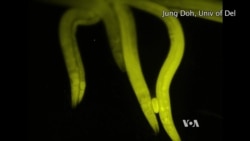Astronauts on future missions to Mars may stay healthier thanks to experiments on Earth with a tiny, almost microscopic worm.
Long-term space travel in low or zero gravity changes how the blood circulates, weakens the immune system, and causes motion sickness, muscle loss and fatigue. It can also trigger bone loss. So scientists at the University of Delaware’s Biotechnology Institute are testing the effects of weightlessness on C. elegans, a transparent invertebrate that is often used in biomedical studies because of its short two-week lifespan. Plus, 70 percent of the worm's DNA is the same as our own.
With funding from NASA, the U.S. space agency, Chandran Sabanayagam and his team built a microgravity simulator in their lab to see how C. elegans would perform in the actual zero gravity of space. The worms are placed in a container of liquid, and as they start to sink to the bottom, the container is flipped upside down, again and again, and the worms never hit the bottom.
"So essentially it’s in free fall, similar to a satellite orbiting the Earth,” Sabanayagam said.
As the worms are spun in free fall, scientists observe them under a microscope. “After about a week of rotation in that environment," Sabanayagam said, "we’ll take the animals out, and what you see us doing with the test tubes is basically biochemical preparation to analyze its genetic material.”
The scientists are looking for changes in the worms' epigenome, the chemical markers that tell the DNA in the cells how to behave. The epigenome can be altered by the environment, and the changes can be passed from one generation to the next.
“When the worms are in a liquid environment, some epigenomic marks persist even when we take the animal out of the liquid environment and put it back into normal ground conditions. So its offspring retains this epigenomic memory of the parents’ liquid environment or microgravity environment,” Sabanayagam said.
So far, the data suggest that the epigenomic marks passed on to future generations are acquired during embryo development. Sabanayagam said identifying that genetic marker is critical to human studies in the future.
“Our work with the worm speeds up this process," he said. "We think that we can find similar genes that responded to microgravity in the worms. We think that we can find them in the human genome and possibly closely monitor those when astronauts go in the space station, travel to the moon or potentially Mars.”
Sabanayagam expects C. elegans to fly on the International Space Station within two years. He hopes in the long term the data can be used to develop simple, cheap and quick tests to assess an astronaut's health.
The work was presented this week at the annual meeting of the Biophysical Society in Baltimore, Maryland.









